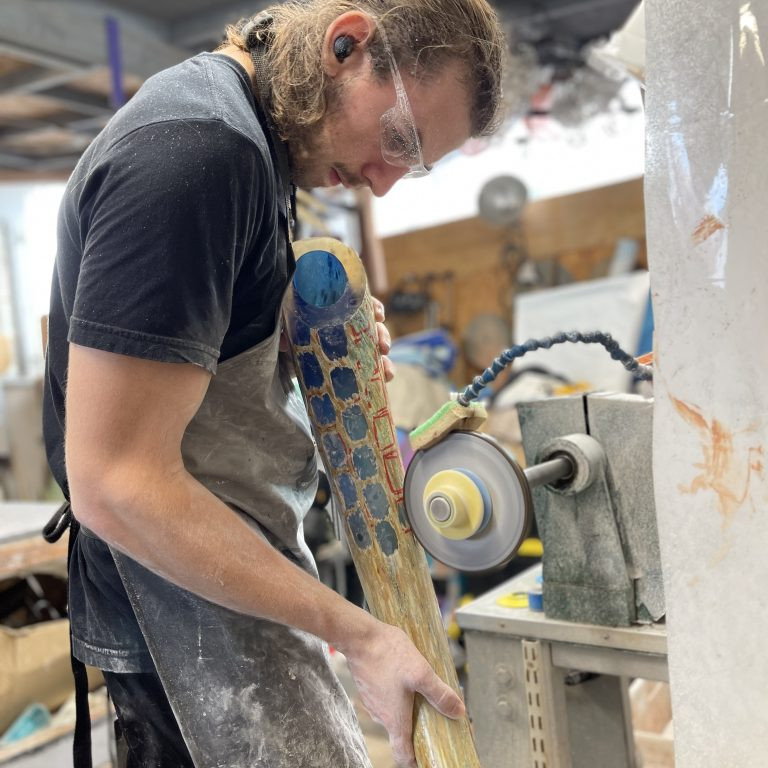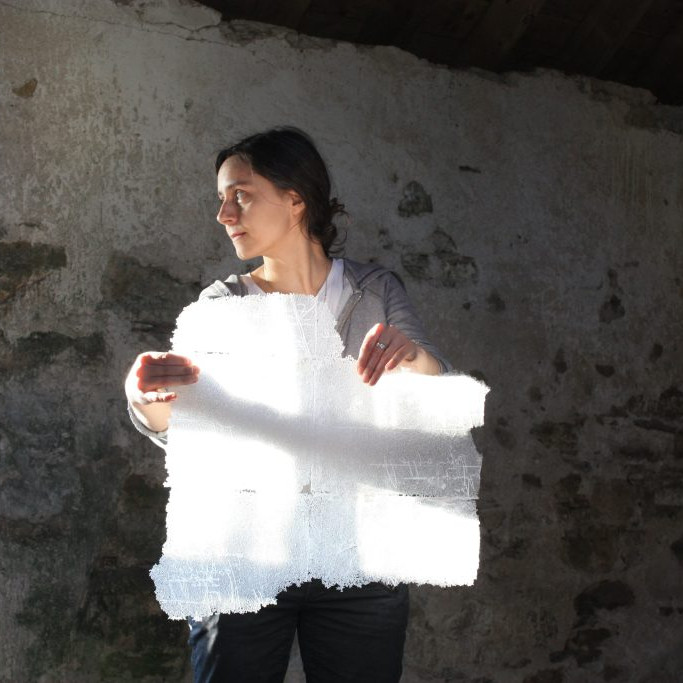David and Jennifer Clancy Glass Artists - Rhode Is, USA
What lead you to move from being a weekend glass artist to having a full time studio and company, Clancy Designs?
David and I both value the time that was spent learning the craft of glass and working for other artists. In earlier times artisans spent years and years working under the masters before forging their own path. Once we felt we had established an aesthetic and a proficiency with the glass it was only a matter of time before we we’re going to reach for the goal of having our own studio.
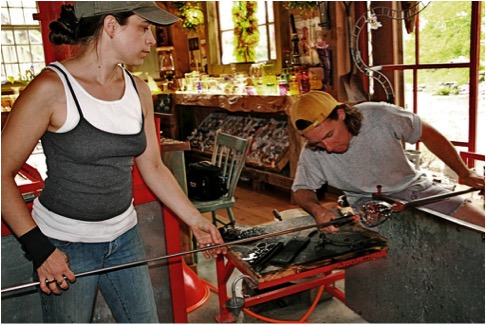
David & Jennifer at work
Is it important that much of your glass is functional?
One of the seducing qualities that the material glass offers is its magical relationship with the maker. This fluid that turns into a solid is given life and shape through the breath. The bubble’s natural expansion with the breath is a rounded shape that calls out to the hands for holding. The day after making one’s first vessel it is ready to be held in the hands of the maker and used in everyday life. A hand-blown drinking glass, especially of one’s own making, is one of the most decadent ways to experience a simple glass of water.
No matter how elaborate, technically challenging, or beautiful our Nature Sculptures get I don’t think we’ll forget the basic pleasure of using our glass every day.
Discuss the importance you share for providing customers with unique pieces in their everyday life?
Before building our glass studio, David and I spent several years renovating our 1787 home. With lots of help from family and friends we were able to do the project ourselves which was fortuitous as with not very much money we couldn’t have afforded to hire the task out. Being that intimate with the project really allowed us to pay attention to every nook and cranny of our space. This was to be our home why not take the opportunity to make it really ours, to make it special. In the end the renovation ended up being an expression of David and I’s creative nature, in and of itself it became our art. This experience has stayed with us and it is one we hope to share with all of our clients. When we work with them on a project or a custom piece we want our glass to contribute to the creation of a space that is a deeper expression of themselves. We hope our work helps transform their physical shelter into more of a home. We hope our work brings light, life, and joy.

In 2004 you opened your own workplace. Can you explain how this happened?
After finishing the renovation of our home the time was right for starting on the glass studio. Luckily for us a friend who has a talent with post and beam structures offered to work with us on building our studio. David had the pleasure of working with him for weeks shaping the posts, beams, and carving out the pegs. In an afternoon a crane and a handful of helpers pulled all the pieces together and we were on our way.
Running, maintaining, and paying for a glass studio is a truly daunting task, but the commute across the lawn, past our beautiful gardens to a job we love is priceless.
Can you discuss your work Superfruit.
The Superfruit Line of tableware was designed by David before he and I met. It uses an Italian technique (pulling glass cane and cutting it into dots) and is a simplified version of Millefiori called Murrini. The goal with this line was to create functional pieces that are bright and cheerful in colour and comfortable in use. It is our most extensive line and for many years quite popular with our clientele.
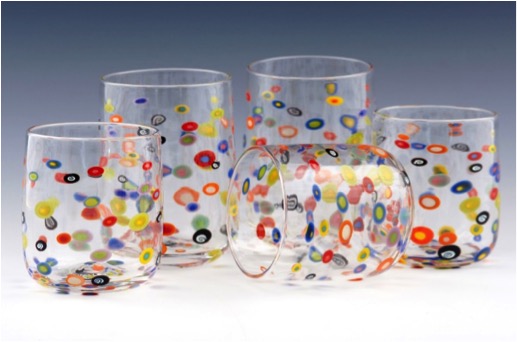
Many customers have told us (separately and without knowing each other) that they call this line their “Happy Glass” and use it joyfully and frequently.
Take two of your drink ware collections and discuss the inspiration for their design?
Pops!
The Pops Tumbler was developed to offer people a physical experience with the glass. In this piece the shape takes the lead. In what I have always thought of as Venus like curves the Pops Tumbler fits directly in the hand following the natural curve of the palm when the hand is partially closed. It is a satisfying feeling to see the look of pleasant surprise on the customers face when they first hold a Pops Tumbler. Of course we always strive for each piece to have its own physical relationship with the user, but this particular line takes the gold! We kept the Murrini for decoration because people love the spots so but made the colour more subtle so the spots wouldn’t try and steal the show.
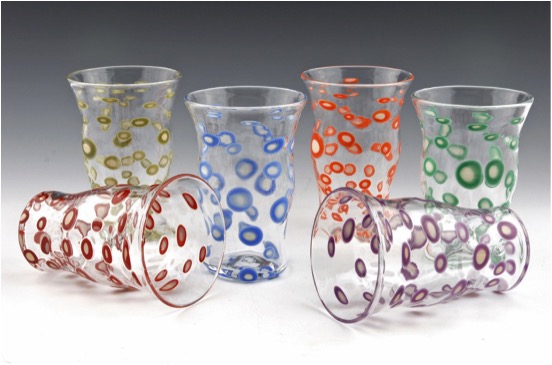
River
The River line developed when we were looking for a way to express a stripe. After years and years of dots they began to take a visual toll. Our solution was to trail colour up and down the piece thus giving it something stripe-like but also allowing the clear glass to provide a canvas for the study of colour. Each colour is represented with its neighbour on the spectrum as an accent. For example the green tumbler also has gold and blue and the blue tumbler also has green, indigo and purple. As an added bonus the trails of colour also provide ridges so all the way around the glass there is texture for the hand to enjoy.

Discuss you Hoop bowls and the way you have used colour in them?

The Hoop Tumblers, Bowls, and Carafe decoration came to us while experimenting.
Experimentation in the studio is a very important part of the process as it allows for the conscious mind and the subconscious mind to play in a sort of three dimensional sketch book. Every year we hope to add an additional design to our Drinkware Line.
We have a strong representation of the dot and the vertical line but not of the horizontal line. The Hoops allow us to do that and as well, like with the River Tumblers, play with colour relationships. Although from a distance each piece seems to be “a” colour, up close one can see more complexity. For example the Red Hoops are composed of 4 different threads of coloured glass – pink, tangerine, red, and cranberry giving the overall appearance of Red a bit of contrast and vibration enriching the visual experience. On occasion we have an opportunity to play with more disparate colour and create, usually on bowls, quite unusual combinations that create beautiful and unique palettes. One of our more popular pieces gave off a vague purple hue, with a bit of earthiness thrown in. Upon closer inspection it shows threads of turquoise, lime, brick red, tangerine, purple, lavender, and off-white. In this line the combination of a clean tight shape and graphic coloured lines truly makes for a striking piece.
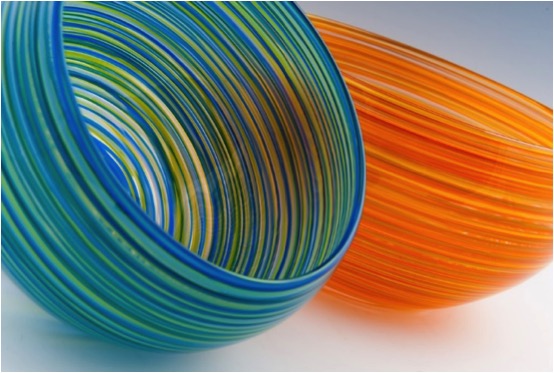
Can you explain your piece called “Hosta”?
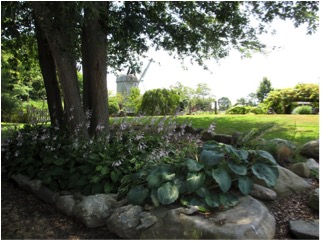
The Botanical Series came out of a love David and I have for nature. We have several gardens on our property and get much joy out of creating and tending them. It was a natural step for us to pay homage to our local flora.
Outside of the glass studio on the way to the house is a large grouping of Hosta. Every day we walk past them. They are touchstone for each season from breaking out of the soil in the spring, leafing out in the summer, and blooming early fall to dying back in the winter letting us know another year has passed. It was easy to want to try and replicate these wonderful plants with their interesting leaves and delicate spires. Trying to capture the essence of a plant provides us a challenge we can really get our teeth into. Although we are never able to create plant life as detailed as Mother Nature does, it certainly is fun trying to achieve all those nuances.
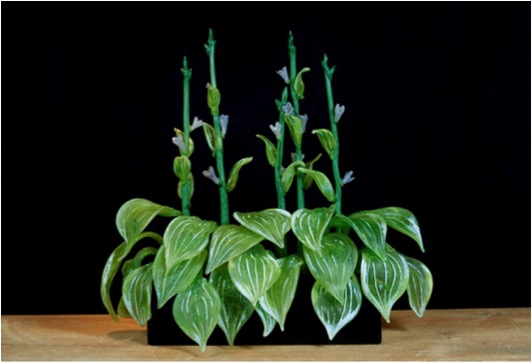
Can you explain how you have used steel and light in your work “Prairie Grass”?
I have long been taken with grass, almost to the point of obsession. One of our first botanical pieces was grass. I love the way each blade contributes to the whole of it creating the “lawn” or in the case of a prairie the “sea” of grass.

When we do it correctly one can almost image it swaying in the wind.
One of the challenges of the botanical pieces is to create a base that holds the individual pieces in place without taking away from the whole sculpture visually. In Prairie Grass the base is one of the lowest to the ground we’ve used, in the hopes of keeping the viewer’s eye on the grass itself. With the application of a patina to the steel base creating earth tones (aka “ground”) I think we have achieved that end. The beauty of the Carex Testacea (Prairie Fire Grass) is that at a certain time of the year the tips turn golden and red. Showing this piece in front of a floor to ceiling window with sunlight streaming through is quite an experience to behold but when night comes or if we’re showing it in a gallery setting back lighting with artificial light has really brought the piece to life in a powerful way – almost as if it really were on fire.
Colour is held so well in glass. Can you comment on this statement?
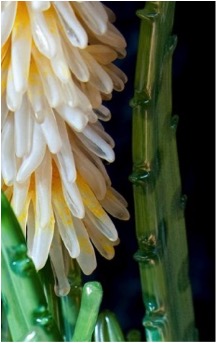
Nature provides us with an unlimited amount of colour. Some of it is bold, some subtle but all of it is alive shining from the inside out. For me glass is the only medium that captures that essence. When light shines through glass and glows it such an impactful experience on the eye. Anyone who has had the pleasure of seeing sunlight shine through rich cobalt blue glass can never erase that experience from the memory. Even frosted glass has a certain play with the light, where you can almost hear a sort of humming from the colour.
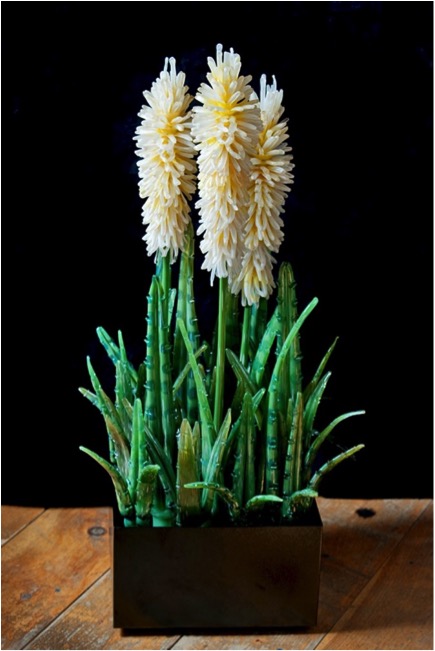
You also make custom pieces for the home and work with designers, discuss this aspect of your work?
David and I took so much care with creating the spaces we move through, both in the home, studio, and yard that we wanted to be able to do that with and for others. For a long time we’ve had home owners and designers commission sculptures and/or lighting from us. Every now and then a space needs a focal point or an added accent to what has been created there. We take this job very seriously and always enjoy getting to know the owners taste and the designers style that we may work in concert with them creating a piece of art that is ours but nods to all the members of the project and respects the space.
Expand on the importance of ‘Handmade’ to you both.
David
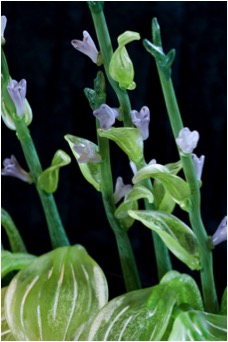
I am reminded of a quote when you ask about handmade:
“When buying from an artist/maker, you’re buying more than just an object. You are buying hundreds of hours of failures and experimentation. You are buying days, weeks, and months of frustration and moments of pure joy. You are not just buying a thing, you’re buying a moment of someone’s life. Most importantly, you’re buying the artist more time to do something they are passionate about.”
Jennifer

I cannot express enough how passionately I feel about the handmade. Machine made items are necessary for our lives but, they will never be able to provide the user with the kind of personal experience that a handmade item can. The handmade object has a life to it, some may even call it a spirit. Handmade items provide a depth of experience when holding or using that touches all the senses. The act of making is also important and an experience that everyone should have in order to express their own creativity and truly understand the value of other handmade objects.
Contact details:
David & Jennifer Clancy
Clancy Designs Glass Studio
382 North Road
Jamestown RI 02835 USA
401-423-1697
www.clancydesigns.com
glass@clancydesigns.com
David and Jennifer Clancy, Rhode Is, USA
Interview by Deborah Blakeley, December 2014
Think a colleague or friend could benefit from this interview?
Knowledge is one of the biggest assets in any business. So why not forward this on to your friends and colleagues so they too can start taking advantage of the insightful information the artist has given?
Other artists you may be interested in:



